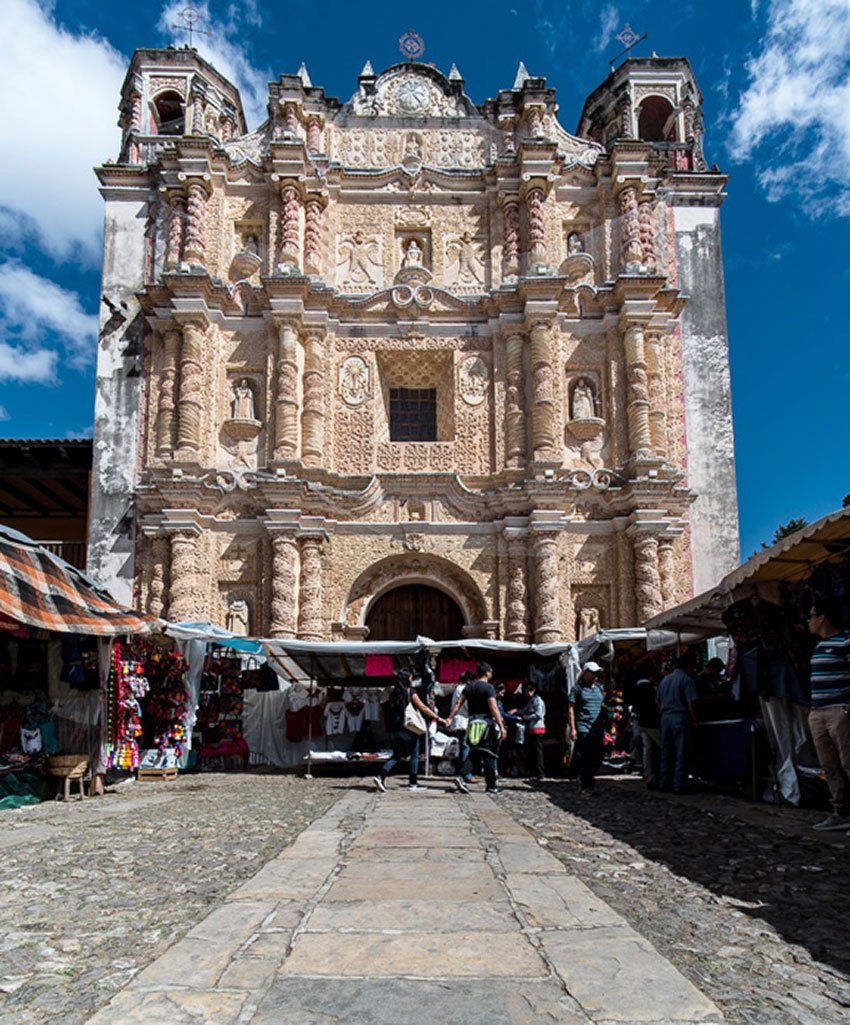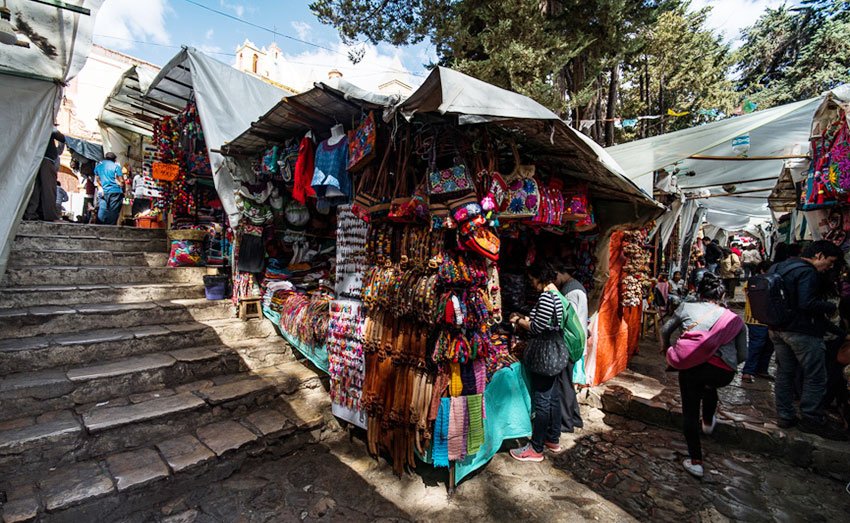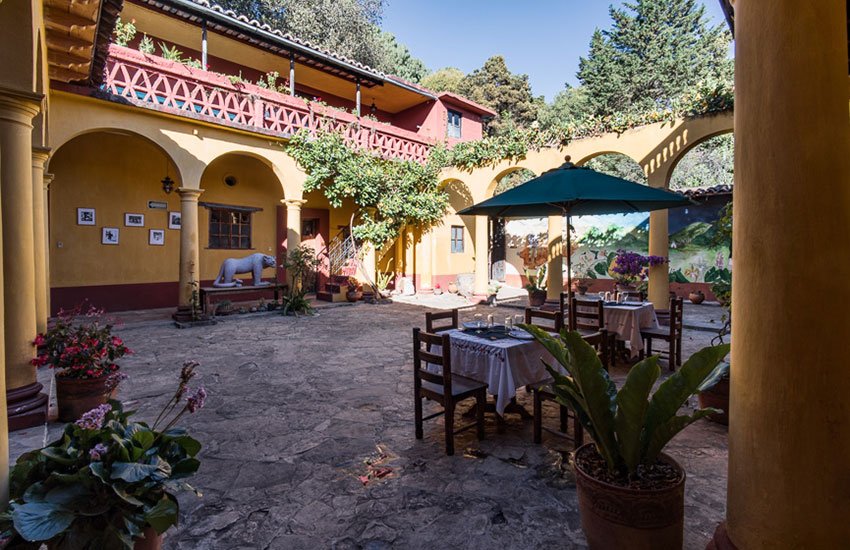Few cities in Mexico combine colonial architecture with indigenous heritage like San Cristóbal de las Casas.
This Pueblo Mágico is famous among adventurous tourists looking for a unique Mexican experience, and one neighborhood in particular provides this experience in spades.
Founded by freed indigenous slaves in the middle of the 16th century, El Cerrillo hosts some of San Cristóbal’s top attractions, from the arts and crafts of the artisan market to the museum and library in Casa Na Bolom. A day spent exploring this neighborhood is well worth it for any visitor to San Cristóbal.
I begin in the Museo de Los Altos de Chiapas to learn more about the history of Chiapas and San Cristóbal de las Casas. The museum is housed in the Ex-Convento de Santo Domingo, one of the oldest buildings in San Cristóbal, on the western edge of the El Cerrillo neighborhood.
Inside the baroque styled ex-convent, the museum houses a collection of artifacts from both pre-Hispanic times and the period of colonization by the Spanish. Alongside the relics, there is a dedicated space to the history of the town up to the end of the 19th century.

Here, I learn that the city, originally called Villa Real, was founded by Spanish conquistador Diego Mazariegos in 1528, making it one of the oldest colonial towns in Mexico. However, the local Tzotzil and Tzeltal people call the area Jovel, meaning “the place in the clouds.”
That’s perhaps a more fitting name, given the usual low-lying fog that greets early risers most mornings in San Cristóbal de las Casas.
Being a lover of maps, my favorite piece in the museum was the wall-sized city plan dating from 1844. Written in the margins of the map is the history of the various barrios of San Cristóbal at that time, including the fascinating history of El Cerrillo.
In the conquest of Latin America, the Spanish set up encomiendas, a system that granted land rights to conquerors and other well-connected elites, and allowed these encomenderos to exploit the labor of the native population. These encomenderos rarely treated the laborers well and in 1549, a Spanish judge named Gonzalo Hidalgo de Montemayor arrived in San Cristóbal to investigate the mistreatment of the indigenous.
Upon discovering many of the abuses the encomenderos inflicted upon the workers, he ordered the indigenous released from slavery. While some returned to their homes, most of the now free people established the El Cerrillo neighborhood on a small hill overlooking the center of town. Here, they were free to live in their own settlement, alongside the Spanish.
Occupying the same building as the museum, the Centro de Textiles del Mundo Maya hosts one of the finest collections of the most ubiquitous form of Mayan art: textiles. Elaborately designed homemade clothing is found everywhere in the city, as most of the native population still wear their traditional dress every day. However, I didn’t realize the importance of the dress to the indigenous until I visited the Textiles Center.

The craft is a form of artistic expression and has been passed down from generation to generation, dating back to pre-Hispanic times. Although methods and materials have changed and evolved since the classic period of Mayan civilization, the importance of the art to the modern-day descendants of the Maya still exists.
Most communities have their own distinct styles and incorporate various materials based on the local climate. For example, in the warmer areas such as Lacanja, cotton is generally used, while areas with colder climates, such as nearby San Juan Chamula, wool is the primary fabric used.
The center hosts upwards of 2,500 pieces of textiles from all over the region, with items rotating in and out of display to prevent the older materials from degrading too much. Also inside is a gallery area, where temporary exhibits are displayed throughout the year.
Right on the steps of the ex-convent is the local artisan market, San Cristóbal’s largest market for handcrafted textiles. The maze-like outdoor bazaar is packed full of vendors selling brightly colored and detailed shirts and blouses, blankets and bags. Along with the textiles, the market also has vendors selling amber and jade jewelry from the town of Simojovel, located to the north.
While I enjoy meandering through the artisan market and admiring the artisanal goods, food markets are more my thing, so I make my way north along Avenida Gral. Miguel Utrilla to Mercado Municipal Jose Castillo Tielemans.
In the outer plaza in front of the mercado, rows of large umbrellas and tarps provide shade for the vendors in the open-air portion of the market. Mangos and papayas are stacked high in buckets, while fresh lettuce, tomatoes and onions await local shoppers looking for their weekly groceries.

Many Tzotzil and Tzeltal people make their living selling the fruits and produce that come from the countryside of Chiapas, and the market is ground zero for locals looking to do their weekly shopping.
I enter the front doors of the market and wait for my eyes to readjust from the bright sun outside to the dimly lit interior.
As I regain my vision, I notice the different world inside, with rows of fruit vendors replaced by butchers and fish shops. The aroma of spices and meat from nearby taco stands fill the air as I make my way through the market, past the squawking of live chickens and turkeys, and out the back and on to the city streets.
I wander through the cobblestone alleyways, through El Cerrillo’s main plaza where the 17th-century Temple of the Lord of Transfiguration still stands, up and down the hilly terrain, past galleries, residences and restaurants housed in multicolored colonial buildings designed with elaborate ironwork, to finally reach Casa Na Bolom on the far side of the neighborhood.
Casa Na Bolom, or House of the Jaguar in the Lacandon language, is a museum, restaurant and hotel with a focus on preserving Lacandon culture and heritage while working to conserve the rainforest of Chiapas.
Originally the home of Danish explorer Frans Blom and his journalist and documentary photographer wife Gertrude Dubi Blom, today the museum hosts many of the artifacts and findings from Frans Blom’s numerous expeditions into the jungles of Chiapas from the early and mid-20th century.
The inner courtyard is reached via a mustard yellow entranceway, where a garden-like atmosphere with vibrant flowers and green plants competes with large trees for the sunlight from the sky above.
Doorways on each side of the courtyard lead to various exhibits, from art galleries and selections of Gertrude Blom’s photography to artifacts from the Lacandon jungle and ancient Mayan ruins such as Palenque.
A connecting walkway near the back of the property leads to a smaller, more jungle-like courtyard. Down a narrow path, a grand room with a beautiful brick fireplace and an expansive bookshelf appear. How I yearn to pull up a seat in front of a fire and glance through one of the 9,000+ books on the shelf! But alas, it’s time to leave and head back to the center of town.
As one of the oldest neighborhoods in Mexico, El Cerrillo provides a glimpse into the history and culture of the indigenous peoples of Chiapas in a well-preserved colonial town. A day spent exploring this area should be on the agenda of every visitor to San Cristóbal de las Casas.
Mark Locki is a Canadian writer and a frequent contributor to Mexico News Daily.
